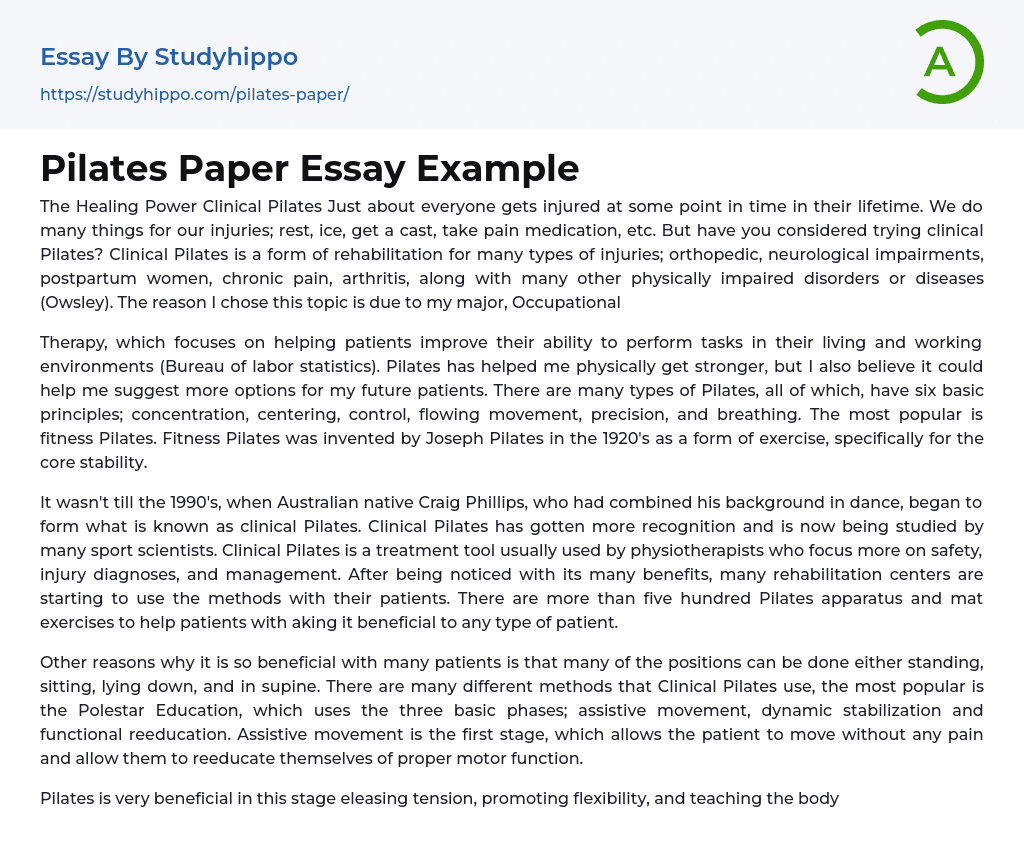Clinical Pilates is a rehabilitation technique that offers an alternative approach for healing various injuries and impairments, including orthopedic and neurological impairments, postpartum women, chronic pain, arthritis, and other physically impaired disorders or diseases (Owsley). Rather than relying solely on traditional methods such as rest, ice, casts, and pain medication, clinical Pilates provides a fascinating alternative for treatment. As an Occupational Therapy student, this topic captivates me.
The Bureau of Labor Statistics states that therapy aims to aid patients in enhancing their ability to perform tasks in their living and working environments. From my own experience, I have discovered that Pilates not only strengthens my body but also holds potential benefits for future patients. There are various types of Pilates, each rooted in six fundamental principles: concentration, centering, control, flowing movement, precision, an
...d breathing. The most popular form is fitness Pilates which was created by Joseph Pilates in the 1920s with an emphasis on improving core stability.
Craig Phillips, an Australian native with a background in dance, pioneered clinical Pilates in the 1990s. This form of Pilates, focused on safety, injury diagnoses, and management, has gained recognition and is now being studied by sport scientists. It is commonly used as a treatment tool by physiotherapists and has been adopted by many rehabilitation centers. With over five hundred Pilates apparatus and mat exercises available, clinical Pilates proves to be beneficial for patients of all types.
The benefits of Clinical Pilates are evident in its adaptability to different patient positions such as standing, sitting, lying down, and in supine. One popular method, Polestar Education, involves three phases: assistive movement, dynamic stabilization, and functional reeducation. The initia
stage enables pain-free movement and allows patients to relearn proper motor function.
Pilates is beneficial during this stage as it helps relieve tension, improve flexibility, and teach the body proper function and alignment. After completing initial assisted movements, patients move on to the second phase of rehabilitation known as dynamic stabilization. The goal in this phase is to increase difficulty by reducing assistance and increasing resistance. To enhance resistance, supportive materials like Pilates balls, rubber bands, trampolines, and Pilates equipment are used. The third stage focuses on preventing re-injury and restoring the body to its pre-injury condition.
By incorporating heavier weights into their Pilates routine or participating in a Pilate's fitness class, individuals can achieve the desired outcome. Clinical Pilates presents an enjoyable and effective alternative to the conventional weight room workout for rehabilitation purposes. Nevertheless, it is important to note that not everyone may be suitable for this type of exercise. Pregnant women should approach specific exercises with caution, and those experiencing chronic back or joint pain should also exercise care. Despite these considerations, clinical Pilates serves as an additional method of rehabilitation that enhances balance, breathing control, and overall body tone.




